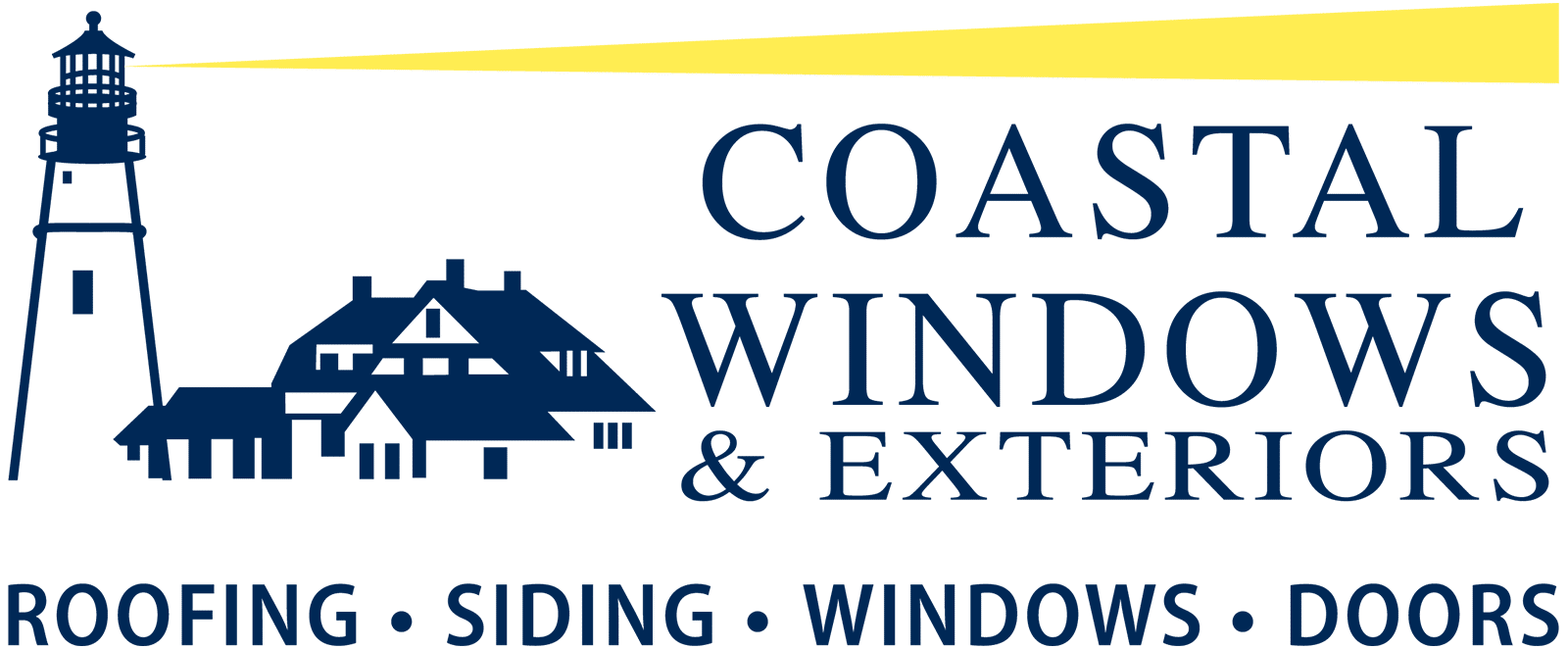New England Ice Dam Guide -Signs and Solutions
Ice dams are a homeowner’s worst winter nightmare, turning the charm of snowy rooftops into costly chaos. These icy barriers form at the roof’s edge, trapping water and leading to problems like leaks, structural damage, and even mold.
Table of Contents
Ice Dam Prevention: Protecting Your Roof This Winter in New England
Without proper insulation and ventilation, your roof becomes vulnerable to winter’s worst threat: ice dams. These icy barriers form when heat escapes your home, melts snow on the roof, and causes water to refreeze along the colder edges. As a result, runoff backs up under the shingles and into your home.
While ice dams may seem like an unavoidable part of New England winters, ice dam prevention is possible with the right strategy.
How Ice Dams Damage Your Home
Unfortunately, once an ice dam forms, the damage can escalate quickly. For example, water can seep under lifted shingles, drip down walls, and stain ceilings. Over time, this may lead to rot, mold, and even pest infestations—like termites drawn to damp wood.
Furthermore, the weight of ice can damage gutters and fascia boards, making repairs more complex and costly. That’s why ice dam prevention isn’t just a winter upgrade—it’s a smart long-term investment.
Understanding the Root Causes of Ice Dams
To effectively prevent ice dams, it’s essential to understand how they form:
Escaped heat from the attic warms the roof’s upper sections
Snow melts, then refreezes on colder roof edges
Ice builds up into a barrier, trapping water behind it
Water finds its way into your home
In many cases, this cycle repeats after every snowstorm. However, with proper attic ventilation, insulation, and roofing materials, you can significantly reduce the risks.
Ice Dam Prevention Tips That Work
Thankfully, there are proven ways to prevent ice dams:
✅ Upgrade Attic Insulation
Proper insulation helps retain indoor heat, keeping your attic cold and preventing uneven roof temperatures.
✅ Ensure Proper Roof Ventilation
Good airflow allows warm air to escape and prevents heat buildup under the roof deck.
✅ Install Ice & Water Shield Barriers
These protective membranes create an added layer under shingles to block water intrusion.
✅ Clean Gutters Regularly
Clogged gutters trap snow and ice, which increases the chance of ice damming. Therefore, clean them before and during winter.
✅ Schedule a Roof Inspection
Before winter begins, have a roofing expert inspect your shingles, flashing, and insulation to identify vulnerabilities.
What New England’s 2024–2025 Winter Forecast Means for Your Roof
Are you wondering what kind of winter lies ahead? According to the Farmers’ Almanac 2024, New England is in for a Wet Winter Whirlwind—with heavy snow, sleet, and freezing rain expected throughout the season.
As a result, conditions will be perfect for ice dam formation, especially for older homes or those without adequate roofing protection. Therefore, proactive ice dam prevention should be a priority heading into this stormy season.
Coastal Windows & Exteriors Can Help You Prepare
At Coastal Windows & Exteriors, we specialize in winter-proofing homes across New England. Whether you’re looking to improve insulation, replace a failing roof, or install protective barriers, we can help safeguard your home before the storms arrive.
🔧 Did you know? A properly installed roof with GAF Timberline shingles and weatherproofing layers can prevent ice dam leaks—even in blizzard conditions.
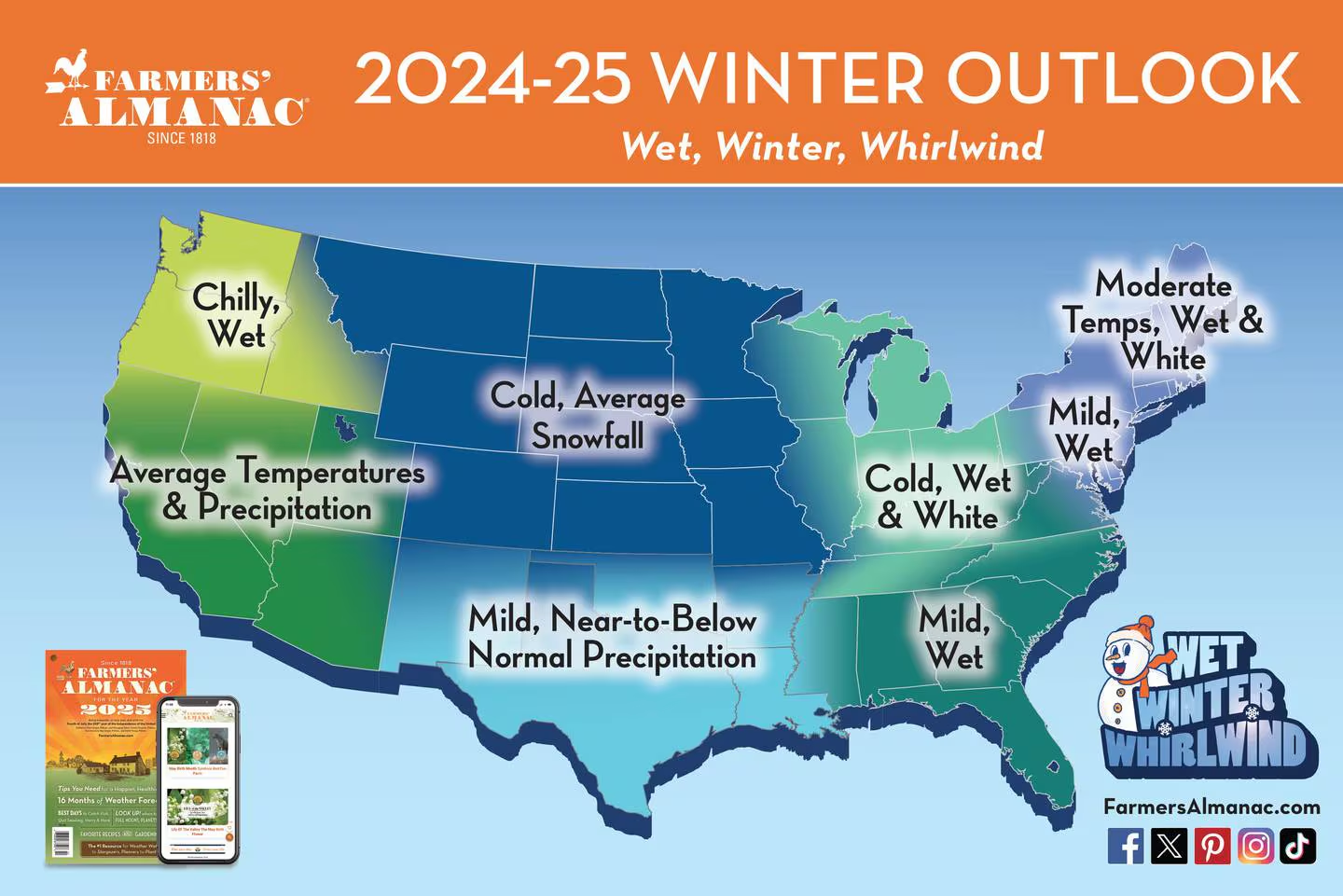
Farmers’ Almanac 2024: What New England Homeowners Can Expect
The Farmers’ Almanac 2024 winter prediction paints a stormy picture for New England—especially along the I-95 corridor. Homeowners should brace for higher levels of sleet, rain, and heavy snow, with coastal areas bearing the brunt of the weather.
In particular, wet snow—which is four times heavier than light, powdery snow—can place immense stress on roofing systems. As a result, the risk of roof leaks and ice dam formation rises dramatically, especially for older roofs or those with insufficient insulation.
The Oreo Cookie Freeze-Thaw Cycle
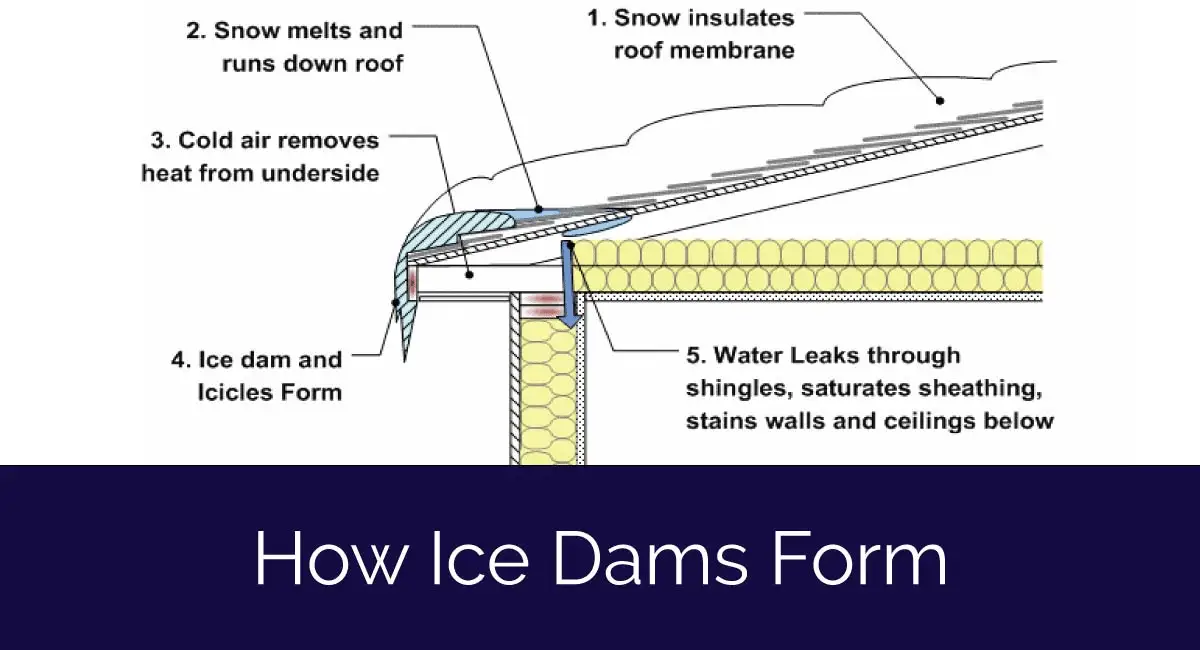
Ice dams often form through a process we like to call the “Oreo cookie freeze-thaw cycle.” This cycle begins when snow melts during warmer daytime temperatures or from heat escaping your attic. As the water flows down your roof, it reaches the colder eaves and refreezes, forming a layer of ice.
Here’s how it works:
- Melting Layer: Snow acts like the cream filling of an Oreo, with the top layer melting due to attic heat or the sun’s warmth.
- Refreezing at the Edges: The water flows down to the roof’s edge, where it freezes into a solid ice layer—the bottom cookie in this analogy.
- Cycle Repeats: As snow continues to melt and refreeze, the layers of ice grow, blocking water runoff and trapping it on your roof.
This repetitive cycle builds an ice dam over time, creating more pressure on shingles and gutters. The trapped water eventually finds its way under shingles. This is ultimately what leads to roof leaks and potentially severe interior damage.
Historical Impact of La Niña
La Niña events have historically influenced weather patterns, leading to notable variations in snowfall and temperature. For instance, during La Niña winters from 1959 to 2024, regions regions like the Great Lakes and Northeast experienced above-average snowfall.
New England La Niña Predictions for Winter 2024-2025
This year, La Niña could significantly influence New England’s winter weather. According to NOAA, there is a 60% chance of La Niña developing. There is also an equal likelihood of above- or below-normal precipitation in Massachusetts and the region. This variability, combined with atmospheric patterns like the polar vortex, makes snowfall predictions uncertain.
These fluctuations make it difficult for snow to remain fluffy and manageable. Instead, rapid warming periods followed by freezing temperatures will encourage ice dams to form at an accelerated rate.
Why This Winter’s Predictions Matter for Ice Dams
New England’s mix of wet snow, sleet, and rain makes ice dams a nearly inevitable challenge for many homeowners. Here’s why these conditions increase ice dam risks:
- Frequent melting and refreezing: Warmer days and colder nights cause snow to melt and refreeze at roof edges, creating solid ice dams. We call this the Oreo cookie freeze and thaw cycle!
- Heavier precipitation: Above-normal snowfall and sleet add extra weight to roofs, putting pressure on shingles and gutters.
- Wet snow accumulation: Denser snow increases the risk of blocked gutters, which can exacerbate rain gutter ice dams and lead to water infiltration.
Can Ice Dams Cause Roof Damage?
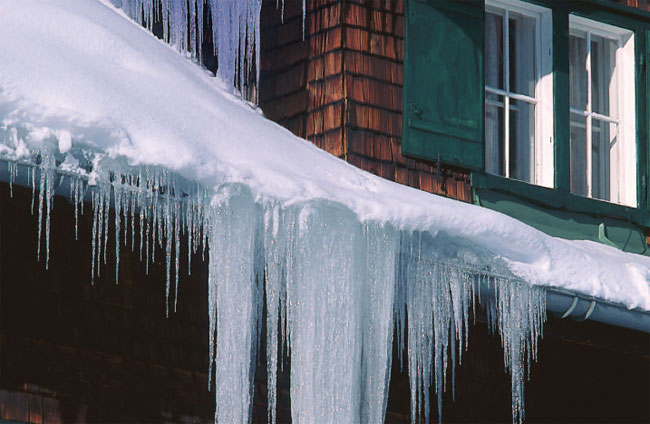
Ice dams may seem like a seasonal nuisance, but they can cause widespread damage to your New England home’s roof, walls, and interior. These frozen barriers compromise the integrity of your roofing system and create conditions ripe for water leaks or structural decay.
Here’s a detailed look at how ice dams can wreak havoc and why addressing them promptly can save you from costly roof leak repair.
Heavy Weight and Roof Damage
Ice dams can grow incredibly large and put a tremendous amount of weight on your roof. In fact, if the ice dam is making your roof leak, you can bank on the ice dam weighing a few thousand pounds.
This immense pressure can lift shingles, exposing areas beneath them to water. When the frozen ice that’s lifted your shingles melts once again, water will seep through your roof and into your home unless you have Roof Deck Protection and Leak Barrier installed beneath your shingles.
The damage caused by heavy ice dams includes:
- Shingle lifting: Ice expands as it freezes, dislodging shingles.
- Exposed roof decking: Once shingles are lifted, water can seep into the roof structure.
- Weakened roof integrity: Prolonged exposure to ice and water can lead to rotting wood.
Interior Leaks and Water Stains

Leaks can travel into walls and ceilings, causing water stains, damage to insulation, and even electrical hazards from water near light fixtures. As ice dams block proper drainage, meltwater pools find a path into your home. This results in visible issues like:
- Water stains on ceilings and walls.
- Dripping or pooling water near windows and fixtures.
- Damp insulation that reduces energy efficiency and promotes decay.
Unchecked, these leaks can lead to the need for extensive roof leak repair, drywall replacement, and insulation upgrades.
Mold and Structural Problems
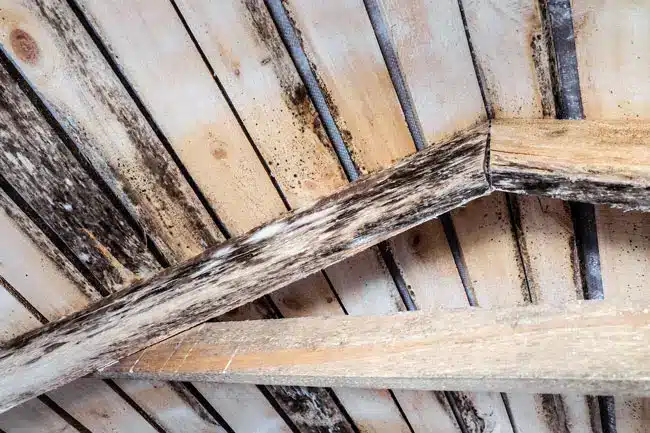
Hidden Ice Dam Damage: What You Don’t See Can Hurt You
Ice dam prevention isn’t just about stopping roof leaks—it’s about protecting your entire home. While visible water stains and ceiling drips are concerning, the real damage often happens where you can’t see it.
Water from ice dams can seep into soffits, walls, insulation, and ceilings. As a result, the structural integrity of your home is put at risk. Even worse, this trapped moisture creates the ideal conditions for mold growth and pest infestations.
Mold: The Silent Threat from Ice Dams
When moisture is left unchecked behind walls and ceilings, mold grows fast—especially in colder months when your home stays sealed tight. Mold isn’t just unsightly; it’s dangerous.
Here’s what makes mold a serious concern:
It spreads rapidly through drywall, ceilings, and insulation.
It harms indoor air quality, especially for people with asthma or allergies.
It leads to costly remediation that may require full wall and flooring removal.
Therefore, preventing ice dams is one of the most effective ways to prevent mold-related damage and expenses.
How Ice Dams Can Attract Termites
Surprisingly, ice dams can even lure termites into your home. These pests are drawn to the very conditions ice dams create—damp, softened wood hidden within walls, beams, and rafters.
Here’s how it happens:
1. Moisture Accumulation
Ice dams allow water to back up under shingles and soak wooden structures. This softens the wood, making it easy for termites to chew through.
2. Hidden Entry Points
Water damage weakens your home, creating cracks and gaps where termites can enter unnoticed.
3. Unchecked Infestations
Since termite colonies often grow behind walls, you may not even realize you have a problem—until the damage is extensive.
Termite Prevention Starts with Ice Dam Prevention
To prevent termite infestations linked to ice dams, follow these steps:
Install Ice & Water Shield: Apply at least 6 feet beneath your shingles to protect eaves, valleys, and vulnerable areas.
Fix leaks immediately: Don’t wait—moisture spreads fast, and so do termites.
Improve attic ventilation: Dry attics help prevent both mold and termites. Also, seal air leaks to control humidity.
When you take steps toward ice dam prevention, you’re also protecting your home from long-term structural and pest-related damage.
The Cost of Ignoring Ice Dams
Ice dams don’t just threaten your roof—they impact every part of your home. When water infiltrates through the shingles, it can cause damage to insulation, drywall, ceilings, and even electrical systems.
Common (and costly) repairs include:
Roof replacement from rotted decking and lifted shingles
Drywall and ceiling repairs from interior leaks
Electrical rewiring when moisture compromises outlets and fixtures
Flooring and insulation replacements after prolonged water exposure
By addressing ice dam prevention early, you can avoid these expenses and keep your home—and your wallet—protected.
Coastal Windows & Exteriors: Your Ice Dam Prevention Experts
At Coastal Windows & Exteriors, we specialize in helping New England homeowners safeguard their homes before winter damage occurs.
With proper attic insulation, roof ventilation, and modern moisture barriers, we stop ice dams before they start. Our GAF-certified roofing systems and expert crew ensure peace of mind through the snowiest seasons.
Warning Signs for Ice Dams
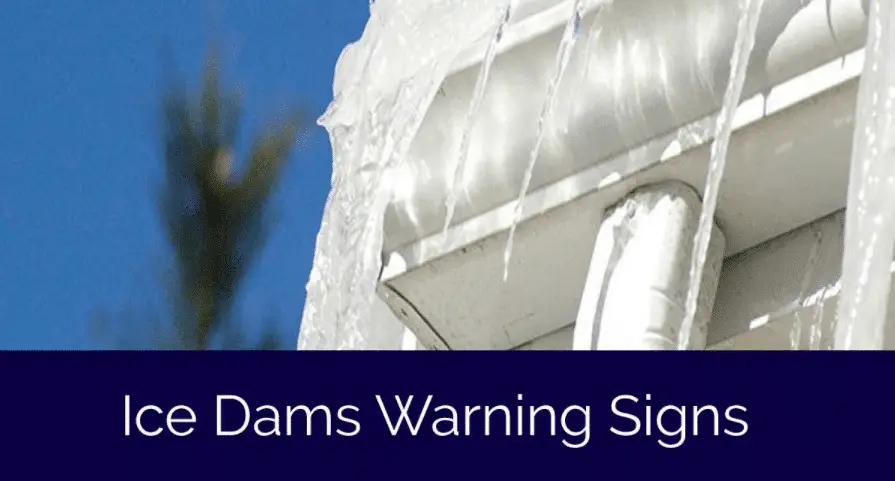
Ice dams don’t form overnight—they often develop gradually, showing subtle signs before causing significant damage. Catching ice dam formation early can help you protect your home and avoid the need for roof leak repair. Below are the key indicators that ice dams may already be forming or that your home is at risk.
Early Warning Signs that Ice Dams May Form
It’s time to think about prevention in this phase of ice dam warning signs. Before the snow even falls, your home might already hint at vulnerabilities. Mold, moisture, and irregularities in your attic are major clues. Watch for the following:
- The temperature inside your attic is not the same as the temperature outside.
- Condensation on items and/or signs of water where it shouldn’t be.
- Drafts around your chimney, recessed lighting receptacles, or bathroom fans.
- Unreasonably high energy bills caused by heat escaping into the attic.
If your roof is flat or slightly pitched, also look for signs like bent, bowed, or cracked rafters. These structural irregularities could signal that your roof won’t handle heavy snow and ice, which may lead to ice dams on roofs.
Red Flag Warning Signs – Take Action Now!
Once winter arrives, the signs of ice dam formation become more obvious. Large icicles hanging off the side of your home or thick snow glares at least 5” thick are clear indications. Here’s what else to look for:
- Leaking windows that appear to have condensation or water dripping inside.
- Water stains on your ceilings or walls, especially near light fixtures.
- Ice buildup in your gutters or at the roof’s edge, leading to blocked drainage.
These issues can quickly escalate if left unresolved, leading to roof leaks and damage to insulation, drywall, or even electrical wiring. Unchecked moisture can seep into your walls, floors, and ceilings, creating the perfect environment for mold. Over time, structural beams and roof decking may rot, requiring costly replacements.
At Coastal Windows & Exteriors, we want you to have a safe winter season, free from ice dams! In the next section, we’ll explore proven methods to prevent ice dams from forming, saving you the stress and expense of dealing with their aftermath. Stay ahead of winter damage by acting on these early warnings!
How to Get Rid of Ice Dams: Proven Methods that Work in New England
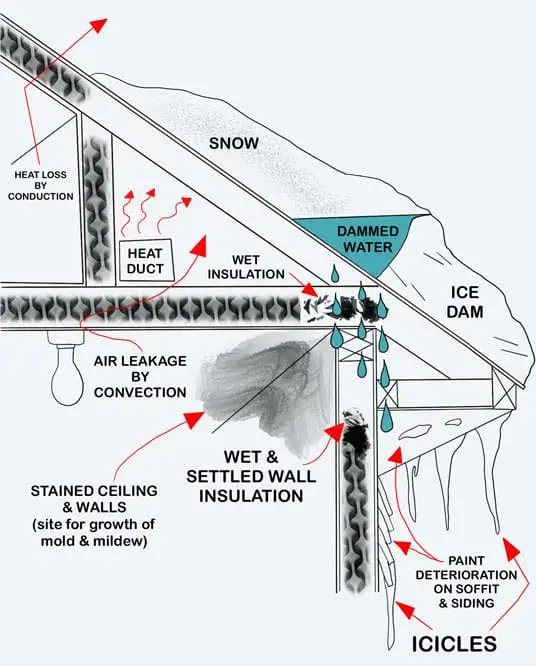
Preventing ice dams requires a proactive approach to addressing the root causes of their formation With proper insulation, improving ventilation, and following best practices for roof maintenance, you can protect your home from the damage these icy culprits cause. Here’s a detailed look at the strategies you can implement to keep ice dams on roofs at bay.
Insulation Matters for Ice Dam Prevention
One of the main causes of a warm attic—and therefore ice dams—is inadequate insulation. Without proper insulation, heat escapes into your attic, warming the roof and melting snow that refreezes at the edges. To prevent this, ensure your attic meets recommended R-values for insulation (at least R-38 or higher in colder climates).
Seal air leakage areas around recessed lighting cans, electrical cables, and vent pipes. Gaps in these areas allow warm air to escape, heating the attic and creating ideal conditions for ice dam formation. Use caulk or foam to close these gaps and maintain consistent attic temperatures.
Prevent Ice Dams with Airflow in Your Attic
Ventilation in your attic space is essential to maintaining the correct temperature. An attic should mirror outdoor temperatures to prevent snow from melting and refreezing on your roof. Without effective ventilation, warm air becomes trapped, melting the snow on your roof. It then refreezes at the colder edges, forming ice dams.
The key to proper ventilation lies in the balance of intake and outtake vents:
- Ridge Vents: Installed along the peak of your roof, ridge vents act as outtake vents that expel warm air from the attic. This constant airflow prevents heat buildup, ensuring your roof stays cool even when your home is warm. GAF Cobra® Ridge Vents are an excellent choice for reliable, high-performance outtake ventilation.
- Soffit Vents: Located under the eaves of your roof, soffit vents function as intake vents. They draw in cold air, which pushes warm air upward and out through the ridge vents. Pair these with GAF Intake Vent Products, such as Cobra® IntakePro™, to maintain the perfect airflow balance.
When ridge and soffit vents work together, they create a continuous flow of air that keeps your attic and roof temperatures consistent. However, ventilation isn’t as simple as installing vents—it needs to be properly calculated and implemented:
- You should have 1 square foot of ventilation for every 300 square feet of attic floor space.
- Intake vents (soffits) and outtake vents (ridges) must be balanced to ensure smooth airflow. Too much of one can disrupt the system and reduce effectiveness.
In addition to using top-quality products like GAF Cobra® Ridge Vents and GAF IntakePro™, it’s crucial to check for obstructions. Blocked soffit vents—caused by insulation or debris—can prevent cold air from entering the attic. Periodically inspect and clear vents to maintain their function.
How to Prevent Ice Dams and Gutters: Gutter and Roof Maintenance Matters
Regular roof maintenance is another critical step in preventing ice dams. Clean your gutters and downspouts before winter to ensure proper drainage of melting snow and rain. Blocked gutters can trap water, leading to rain gutter ice dams that worsen ice buildup at the roof’s edge.
In areas prone to heavy snow, use a roof rake to safely remove snow from the roof’s edge. This eliminates the insulating layer of snow that contributes to melting and refreezing.
Will Heated Gutters Stop Ice Dams?
Heat cables and gutter heaters to prevent ice dams can help reduce the chances of ice forming in critical areas. When warming gutters and eaves, these systems can keep water flowing even in freezing temperatures. However, they should be viewed as a supplement and not a replacement for proper insulation and ventilation. Without addressing attic heat loss, these tools won’t stop ice dams entirely. If you are at a crossroads of choosing gutter heaters or a new roof, a new roof will provide you with substantially more protection!
Best Roofing Features for Ice Dam Prevention for New England Homes
Your roof is the first line of defense against ice dams. Equipping it with the right features can make all the difference! From high-quality underlayment to specialized leak barriers, these components work together to protect your home from winter’s icy grip. As a New England homeowners, these are the must-have roofing features that will safeguard your roof and prevent ice dams on roofs.
Ice & Water Shield: The Best Barrier Against Ice Dams
Ice dams form when water from melted snow refreezes at the roof’s edge, creating a barrier that traps additional water. Without proper protection, this water seeps under shingles and into your home. Installing a premium ice and water shield is essential to prevent leaks in vulnerable areas like valleys, eaves, and rakes.
- GAF WeatherWatch® Ice & Water Shield is a top-tier product that provides durable, watertight protection for your roof. We install this product up to 6 feet for ultimate protection.
- It’s particularly effective in areas prone to roof leaks, such as chimneys, skylights, and vents.
- For extra protection, we extend the shield 6 feet up from the eaves to block water infiltration during freeze-thaw cycles.
Roof Deck Protection for Added Durability
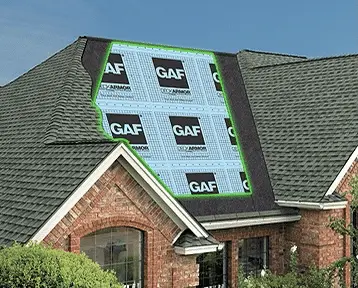
Your roof deck is a durable layer beneath the shingles that shields your home from moisture. Traditional underlayment materials, like tar paper, fail to provide the breathability and durability needed to combat ice dam damage. Modern options, such as GAF Deck-Armor™, offer superior protection:
- Allows trapped moisture to escape while blocking external water.
- Reinforces your roof’s durability during heavy snow and ice.
- Reduces the risk of mold and rot caused by lingering moisture.
High-Performance Shingles Built for Harsh Winters
Shingles help keep your roof watertight. Choosing shingles designed for New England’s unpredictable weather is key to preventing damage caused by ice dams.
- GAF Timberline® HDZ Shingles provide advanced protection with their Dura Grip™ adhesive, locking shingles tightly in place to resist ice and wind. Don’t forget that Coastal Windows & Exteriors offers an Unlimited Wind Speed Warranty! Your shingles are guaranteed to stay in place no matter the severity of wind storms.
- They feature an algae-resistant formula, maintaining curb appeal while protecting your home from harsh conditions.
- Select shingles with extended warranties for long-term peace of mind.
Ridge and Soffit Vents for Balanced Ventilation
Without proper ventilation, warm air trapped in the attic melts snow on your roof, which then refreezes at the edges. Balanced airflow is crucial to maintaining an even roof temperature, reducing the risk of ice dams on roofs.
- Use GAF Cobra® Ridge Vents to expel warm air from your attic.
- Pair them with GAF IntakePro™ Soffit Vents to bring in cold air, creating the perfect balance for a healthy attic environment.
Leak Barriers: Your Roof’s Secret Weapon
Leak barriers act as an additional shield against water infiltration caused by ice dams. These barriers are especially important in high-risk areas where water often pools or seeps.
- GAF StormGuard® Leak Barrier is a premium option that prevents leaks in valleys, around chimneys, and at roof edges.
- Its self-sealing technology offers maximum protection against ice and water damage.
New GAF Roof Installation Prevents Leaks
Protecting your home from ice dams requires more than one solution. Combining these essential roofing features creates a robust system capable of withstanding New England’s challenging winter conditions. Investing in products like Tiger Paw Roof Deck Protection and Timberline® HDZ Shingles helps fortify your roof from leaks, saving you from costly repairs caused by roof leaks and structural damage.
Does Ice Dams Mean I Need a New Roof?
Ice dams can cause significant damage to your roof, but they don’t always mean you need a full roof replacement. The severity of the damage depends on how long the issue has been left untreated and whether water has seeped into critical areas like your attic, walls, or ceiling.
Here’s how to evaluate whether ice dams on roofs signal the need for a new roof:
Signs of Extensive Damage:
- Lifting shingles or missing shingles where water has penetrated.
- Sagging areas in the roof structure caused by prolonged exposure to moisture.
- Mold or rot on roof decking or wooden rafters in your attic.
- Visible water stains or leaks inside your home.
When Repairs Are Sufficient:
- If the damage is isolated to a small area, repairing or replacing damaged shingles and underlayment may be enough.
- Properly sealing leaks and adding Ice & Water Shield in problem areas can prevent future damage.
When Replacement Is Necessary:
- If your roof is already near the end of its lifespan, the combined effects of ice dams and aging materials might make replacement a better option.
- Extensive rot or mold in the roof deck requires a full replacement to restore structural integrity.
Consult a professional roofer to assess the condition of your roof. They’ll inspect for roof leaks, water damage, and compromised structural elements to determine whether repair or replacement is the best solution.
Do Roof Vents Prevent Ice Dams?

Yes! Roof vents can help prevent ice dams on roofs by maintaining balanced attic temperatures. That’s because proper ventilation allows cold air to flow in and warm air to escape, reducing the chances of snow melting and refreezing on your roof.
Key types of roof vents include:
- Ridge Vents: These vents, like GAF Cobra® Ridge Vents, are installed at the roof’s peak to release warm air from the attic. They create a natural airflow system that helps regulate attic temperatures.
- Soffit Vents: These intake vents bring cold air into the attic, pushing warm air out through ridge vents. Products like GAF IntakePro™ Soffit Vents are designed to improve airflow efficiently.
Without proper ventilation, warm air trapped in the attic melts the snow on the roof, which refreezes at the edges. Ventilation prevents this cycle by keeping the roof surface consistent with outdoor temperatures. However, ventilation alone isn’t enough—it works best when paired with proper insulation and air sealing to prevent heat from entering the attic in the first place.
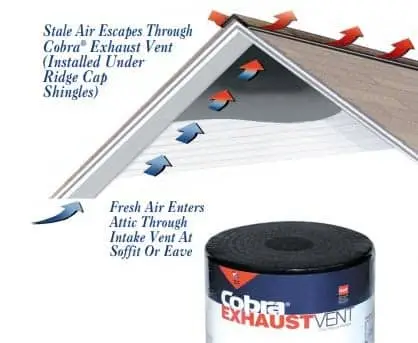
Ice Dam Prevention: Ventilation, Insurance & Common Mistakes to Avoid
When winter hits New England, ice dam prevention becomes more than a precaution—it becomes a necessity. Proper ventilation, insulation, and roofing materials are essential to stop ice from damaging your roof, walls, and home structure. Without a proactive approach, homeowners may face serious problems, from water leaks to mold and even termite infestations.
In this section, we’ll break down action steps for ventilation, why salt isn’t a safe fix, and how insurance might (or might not) cover ice dam damage.
Action Steps for Ice Dam Prevention Through Attic Ventilation
Effective attic ventilation is a crucial part of ice dam prevention. Simply adding a vent isn’t enough. Instead, homeowners should take targeted steps to reduce heat loss and maintain a balanced attic temperature.
✔️ Seal Leaks
First, seal gaps around recessed lights, electrical cables, and vent pipes. These small openings let warm air escape into the attic, warming the roof from underneath. Use caulk or expanding foam to close them up effectively.
✔️ Insulate Light Fixtures
Next, foam around heat-protected recessed lights, ensuring they are zero-clearance and fire-rated. This prevents warm air from pouring into the attic through these fixtures.
✔️ Secure the Attic Hatch
Attic hatches often leak warm air if they’re not properly sealed. Adding weatherstripping or insulation around the hatch reduces heat loss and keeps your attic temperature consistent.
✔️ Clear Soffit Vents
Blocked soffit vents reduce airflow. Consequently, your ventilation system becomes ineffective. Check these areas regularly to ensure they’re free of insulation or debris.
For best results, pair these upgrades with GAF Cobra® Ridge Vents and GAF IntakePro™ Soffit Vents to improve airflow and optimize protection.
Can You Put Salt on Your Roof?
Can you? Technically, yes.
Should you? Probably not.
Although some homeowners use salt to melt driveway ice, it’s not safe for roofs. While it may offer a short-term fix, it creates long-term damage.
❌ Why Salt is a Bad Idea:
Shingle Damage: Salt is corrosive and breaks down asphalt granules.
Gutter Corrosion: Meltwater mixed with salt can eat away at metal gutters and downspouts.
Environmental Harm: Salt runoff damages landscaping and contaminates soil.
✅ Better Alternatives:
Roof Rakes: Remove snow from roof edges safely and prevent buildup.
Professional Removal: Hire experts with tools designed for safe ice removal.
Preventive Systems: Focus on proper insulation, ventilation, and leak barriers for long-term solutions.
Ultimately, smart ice dam prevention methods outperform reactive fixes like salting.
Does Homeowners Insurance Cover Ice Dams?
If you’re wondering whether your insurance covers damage from ice dams, the answer is—it depends. Fortunately, most standard homeowners insurance policies cover sudden damage caused by ice dams. However, there are important exceptions to know.
✅ What’s Typically Covered:
Roof Repairs: Damage from lifted shingles or sudden leaks
Interior Damage: Water stains on ceilings, damaged insulation, wet drywall
Personal Property: If furniture, electronics, or valuables are affected
What’s Often Not Covered:
Preventable Damage: Poor maintenance, like clogged gutters or poor ventilation
Gradual Damage: Mold or rot that develops slowly over time
Ice Removal Services: Costs to physically remove ice from your roof
Steps to Protect Your Home and Minimize Out-of-Pocket Costs
Instead of waiting for damage to occur, focus on prevention. These simple actions can reduce the risk of leaks and limit the impact of winter storms.
What You Can Do:
Maintain attic ventilation to regulate temperatures and prevent ice dam formation
Clean gutters regularly to ensure proper drainage
Schedule roof inspections before winter to catch issues early
Add insulation to prevent heat from reaching your roof
What to Do If Ice Dam Damage Occurs
Despite best efforts, damage sometimes happens. If your home is affected by an ice dam:
Document everything: Take photos of visible damage, inside and out
Contact your insurance: Report the claim and ask what’s covered
Get a professional estimate: Hire a licensed roofing contractor to assess and quote repairs
While insurance may help with some repairs, investing in proper ice dam prevention will save you far more in the long run.
✅ Final Thoughts: Ice Dam Prevention Is the Smartest Solution
New England winters are unpredictable. But one thing is certain: the cost of ignoring ice dam prevention is far greater than the cost of preparing.
With the right ventilation, insulation, and roofing system, you can prevent ice dams—and the headaches that come with them.
Protect Your Home with a Durable Roofing System Built for New England Winters
GAF Roofing System: Full-Protection Roofing for New England Homes
When it comes to protecting your home from the relentless freeze-thaw cycles of New England winters, replacing your shingles alone isn’t enough. You need a complete, weather-tested solution. That’s why homeowners trust the GAF roofing system—a 6-layer defense engineered to prevent ice dams, roof leaks, and long-term water damage.
Unlike basic roofing setups, this system offers comprehensive protection against the unpredictable weather patterns in the Northeast.
Why Choose the GAF Roofing System?
Each layer of the GAF roofing system plays a critical role in preserving your roof’s durability, energy efficiency, and resistance to winter damage.
✅ 1. Leak Barrier
First, the leak barrier protects vulnerable areas like valleys and eaves. Since these are common zones for ice dam formation, this layer blocks water infiltration before it penetrates your roof.
✅ 2. Roof Deck Protection
This underlayment provides a second layer of defense, allowing trapped moisture to escape while preventing external water from entering. As a result, it keeps your deck dry and intact.
✅ 3. Starter Strip Shingles
Starter shingles help secure the first row of shingles and prevent wind uplift. Consequently, your entire roof system becomes more stable and storm-resistant.
✅ 4. Lifetime Shingles
GAF’s Lifetime Shingles feature advanced adhesive technology. These shingles are built to withstand heavy snow loads and high winds—making them ideal for New England weather.
✅ 5. Ridge Cap Shingles
These top-layer shingles protect the roof’s highest points while adding a clean, finished look. Additionally, they help direct airflow through your attic for better ventilation.
✅ 6. Attic Ventilation
Proper ventilation is essential for ice dam prevention. Balanced airflow helps regulate attic temperatures, reducing snowmelt and refreezing cycles on your roof.
Why Choose Coastal Windows & Exteriors?
At Coastal Windows & Exteriors, we go beyond the basics. As a GAF Certified Contractor, we install the full GAF roofing system to manufacturer specifications—ensuring you receive maximum warranty coverage and long-term performance.
Here’s what sets us apart:
Expert consultations with custom roofing assessments
GAF System Plus and Golden Pledge® warranties
Proven experience with New England homes
Financing options and seasonal promotions
Furthermore, we tailor every roof installation based on your home’s layout, attic airflow, and insulation—because one-size-fits-all never works in New England.
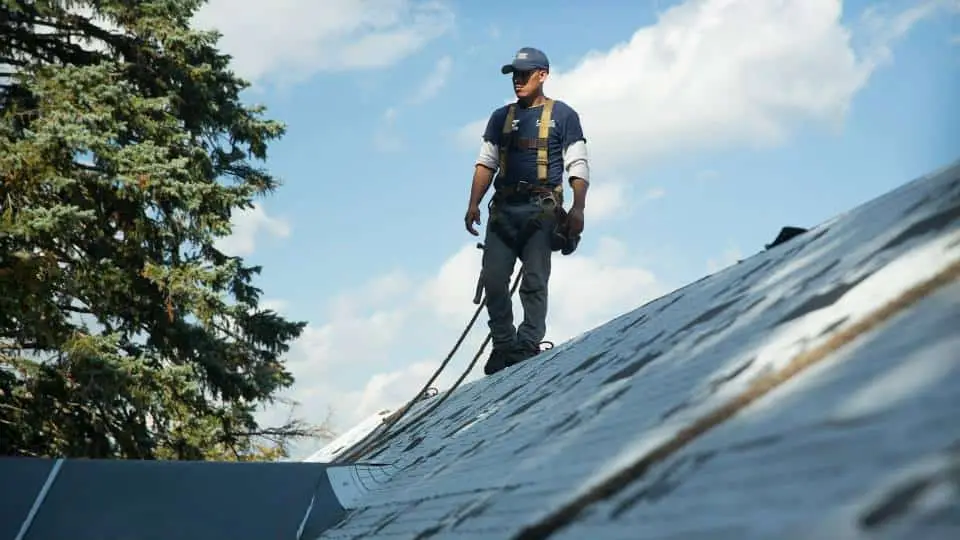
Coastal Windows & Exteriors is the #1 woman-owned roofing company in New England, as recognized by INC 5000 and North Shore Magazine’s Best of North Shore (BONS) Winner for 2023 and 2024. Led by the 2024 SBA Massachusetts Business Person of the Year, we take pride in offering exceptional craftsmanship and premium products, including:
- GAF Master Elite Roofer Certification—only 2% of roofers nationwide achieve this distinction.
- GAF Green Certified Roofer, showcasing our commitment to sustainability.
- Licensed and insured professionals for worry-free service.
- Exclusive warranties like the GAF Unlimited Wind Speed Warranty and GAF Golden Pledge Warranty for peace of mind.
Whether you’re looking for a traditional roofing system, solar roofing, or the durability of metal roofing, we have solutions tailored to meet your home’s needs.
Contact Us for a Free Estimate Today!
Don’t let ice dams and winter storms compromise your home. Protect what matters most with the best in the business—Coastal Windows & Exteriors. Contact us now for a free roofing estimate and discover how our GAF 6-Layer Roofing System can keep your home safe and secure all winter long.
Your roof deserves the best—because your home deserves the best. Let’s get started!

